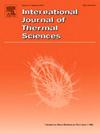R513A作为激光手术喷雾冷却中R134a的环保替代品的评估:传热性能和优化
IF 4.9
2区 工程技术
Q1 ENGINEERING, MECHANICAL
International Journal of Thermal Sciences
Pub Date : 2025-05-24
DOI:10.1016/j.ijthermalsci.2025.110016
引用次数: 0
摘要
在激光手术中,喷雾冷却在减轻表皮热损伤方面起着关键作用。然而,R134a这种全球变暖潜能值(GWP)高达1300的制冷剂的广泛使用带来了严重的环境问题。本研究选用GWP值为573的环保型冷剂R513A,通过自建开环喷雾系统,研究替代R134a的可行性,以及喷雾高度、喷射持续时间、喷嘴孔口直径、喷雾压力对R513A喷雾冷却的影响。实验结果表明,R513A具有较好的冷却性能,其表面温度比R134a低12℃,最大热流密度比R134a高27.5%。此外,R513A提供了更宽的最佳喷雾高度范围(30-50 mm),其中Tmin分别比20 mm和10 mm低4°C和13°C。该范围内的Qmax分别比20 mm和10 mm高10%和16%。虽然延长喷射时间消耗更多的冷冻剂并延长液膜寿命,但Tmin和qmax的差异小于4°C和10 kW/m2。随着喷嘴孔径从0.6 mm增加到1.0 mm, Tmin保持在- 42°C左右,而qmax逐渐增加6 kW/m2。宏观分析表明,较高的喷雾压力导致喷雾更加分散,但这并没有显著提高冷却效率。为了提高对R513A喷雾冷却动力学的认识,建立了一种无量纲相关性来预测不同条件下的动态换热系数。这项研究不仅突出了R513A作为可持续替代方案的潜力,而且为优化喷雾冷却参数以增强激光手术的热管理提供了关键见解。本文章由计算机程序翻译,如有差异,请以英文原文为准。
Evaluation of R513A as an environmentally friendly alternative to R134a in spray cooling for laser surgery: Heat transfer performance and optimization
Spray cooling plays a pivotal role in mitigating thermal injuries to the epidermis during laser surgery. However, the widespread use of R134a, a refrigerant with a high global warming potential (GWP) of 1300, poses significant environmental concerns. In this study, R513A, a more environmental-friendly cryogen with a GWP of 573, is used to investigate the feasibility of replacing R134a and the effects of spray height, spurt duration, nozzle orifice diameter, and spray pressure on R513A spray cooling through a self-built open-loop spray system. Experimental results demonstrate that R513A exhibits superior cooling performance, achieving a minimum surface temperature (Tmin) 12 °C lower and a maximum heat flux (qmax) 27.5 % higher than R134a. Additionally, R513A offers a broader optimal spray height range (30–50 mm) in which Tmin is 4 °C and 13 °C lower than those at 20 mm and 10 mm, respectively. qmax in this range is 10 % and 16 % higher than those at 20 mm and 10 mm, respectively. While extending the spurt duration consumes more cryogen and prolongs the liquid film lifetime, the differences in Tmin and qmax are less than 4 °C and 10 kW/m2. With the nozzle orifice increasing from 0.6 mm to 1.0 mm, Tmin remains approximately −42 °C but qmax gradually increases by 6 kW/m2. Macroscopic analysis reveals that higher spray pressure induces a more dispersive spray, though this does not significantly improve cooling efficiency. To advance the understanding of R513A spray cooling dynamics, a dimensionless correlation was developed to predict the dynamic heat transfer coefficient across diverse conditions. This study not only highlights the potential of R513A as a sustainable alternative but also provides critical insights into optimizing spray cooling parameters for enhanced thermal management in laser surgery.
求助全文
通过发布文献求助,成功后即可免费获取论文全文。
去求助
来源期刊

International Journal of Thermal Sciences
工程技术-工程:机械
CiteScore
8.10
自引率
11.10%
发文量
531
审稿时长
55 days
期刊介绍:
The International Journal of Thermal Sciences is a journal devoted to the publication of fundamental studies on the physics of transfer processes in general, with an emphasis on thermal aspects and also applied research on various processes, energy systems and the environment. Articles are published in English and French, and are subject to peer review.
The fundamental subjects considered within the scope of the journal are:
* Heat and relevant mass transfer at all scales (nano, micro and macro) and in all types of material (heterogeneous, composites, biological,...) and fluid flow
* Forced, natural or mixed convection in reactive or non-reactive media
* Single or multi–phase fluid flow with or without phase change
* Near–and far–field radiative heat transfer
* Combined modes of heat transfer in complex systems (for example, plasmas, biological, geological,...)
* Multiscale modelling
The applied research topics include:
* Heat exchangers, heat pipes, cooling processes
* Transport phenomena taking place in industrial processes (chemical, food and agricultural, metallurgical, space and aeronautical, automobile industries)
* Nano–and micro–technology for energy, space, biosystems and devices
* Heat transport analysis in advanced systems
* Impact of energy–related processes on environment, and emerging energy systems
The study of thermophysical properties of materials and fluids, thermal measurement techniques, inverse methods, and the developments of experimental methods are within the scope of the International Journal of Thermal Sciences which also covers the modelling, and numerical methods applied to thermal transfer.
 求助内容:
求助内容: 应助结果提醒方式:
应助结果提醒方式:


